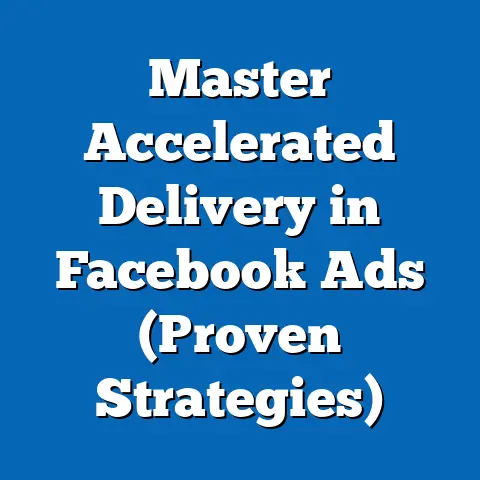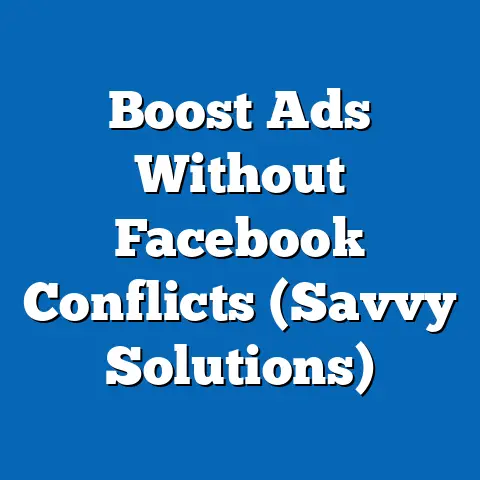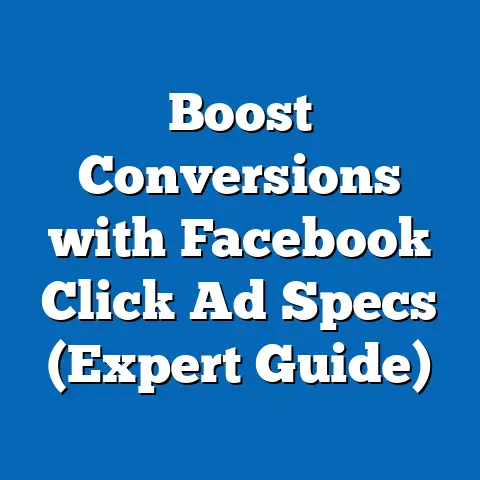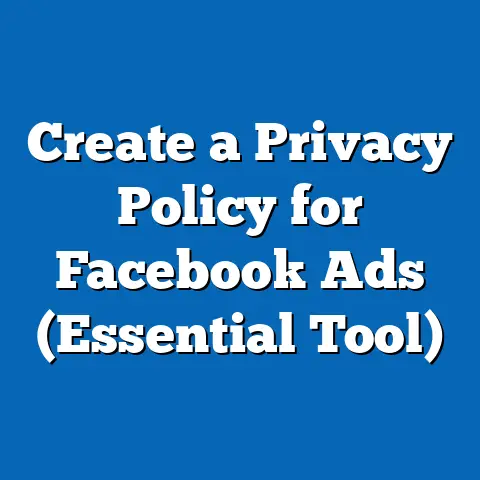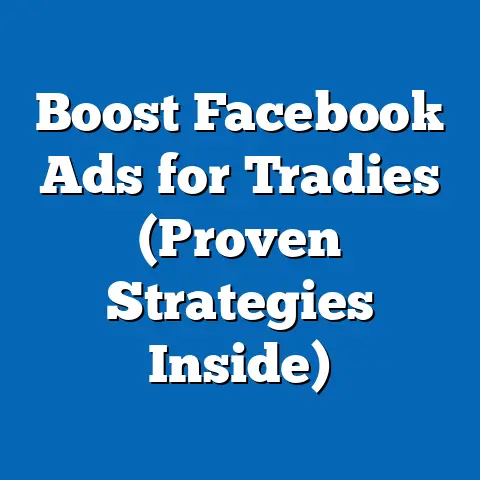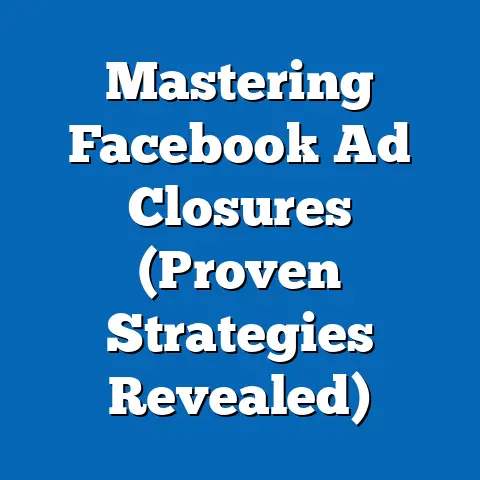Maximize Engagement with You in Facebook Ads (Pro Tips)
Facebook advertising has become a cornerstone of digital marketing, yet with its ubiquity comes a challenge: cutting through the noise. In today’s crowded digital landscape, simply having an ad isn’t enough. You need to create ads that capture attention, resonate with your audience, and drive meaningful engagement. I’ve seen firsthand how blending different creative styles – visuals, text, and interactive elements – can transform a mediocre campaign into a roaring success.
Think of it like a symphony. Each instrument (visuals, copy, targeting) plays a crucial role, but it’s the harmonious combination that creates a masterpiece. With increasing competition on social media, innovation and strategic enhancement of engagement strategies are no longer optional – they’re essential for survival.
In this guide, I’ll share actionable tips and strategies to help you maximize engagement with your Facebook ads. We’ll dive into understanding your audience, crafting compelling visuals and copy, utilizing interactive elements, and the critical role of testing and optimization. Get ready to transform your Facebook ads from simple promotions into captivating experiences that your audience will love.
Understanding Your Audience
One of the biggest mistakes I see businesses make is treating their entire audience as a single, homogenous group. This “one-size-fits-all” approach rarely works. True engagement comes from speaking directly to the needs, interests, and desires of specific audience segments.
The Power of Audience Segmentation
Audience segmentation is the process of dividing your target market into smaller, more defined groups based on shared characteristics. These characteristics can include:
- Demographics: Age, gender, location, education, income
- Interests: Hobbies, passions, topics they follow online
- Behaviors: Purchase history, website activity, Facebook engagement
Why is this important? Because different segments respond to different types of ads. A Gen Z college student is going to be motivated by different messaging and visuals than a Baby Boomer retiree.
Tools and Methods for Understanding Audience Preferences
Fortunately, Facebook provides a wealth of tools to help you understand your audience.
- Facebook Insights (Meta Business Suite Analytics): This is your go-to resource for understanding your existing audience. It provides data on demographics, interests, and behaviors of people who like your page or interact with your content. I use this data to understand what content resonates best with my current audience.
- Audience Analytics: Located within Ads Manager, Audience Analytics offers deeper insights into potential customers. You can analyze the demographics, interests, and behaviors of people who are likely to be interested in your products or services. This is particularly helpful for identifying new target audiences.
- Facebook Pixel: This small piece of code tracks user activity on your website. By analyzing this data, you can understand which pages are most popular, which products are most frequently purchased, and how users are interacting with your site. This information can be used to create highly targeted and personalized ads.
- Social Listening: Don’t underestimate the power of simply listening to what people are saying online. Use tools like Mention or Brandwatch to track conversations related to your brand, your industry, and your competitors. This can provide valuable insights into customer needs, pain points, and preferences.
Tailoring Content to Different Audience Segments
Once you’ve identified your key audience segments, it’s time to tailor your content to each group. Here’s how:
- Messaging: Use language and tone that resonates with each segment. For example, a younger audience might respond well to informal, humorous language, while an older audience might prefer a more professional and straightforward approach.
- Visuals: Choose images and videos that appeal to each segment. For example, if you’re targeting outdoor enthusiasts, use images of people hiking, camping, or enjoying nature.
- Offers: Create offers that are relevant to each segment’s needs and interests. For example, if you’re targeting students, offer a discount on educational products or services.
I remember working with a client who sold high-end skincare products. Initially, they were running a single ad campaign targeting all women aged 25-55. The results were underwhelming. After segmenting their audience based on age and skin concerns, we created separate campaigns with tailored messaging and visuals. The result? A 30% increase in conversion rates.
Takeaway
Understanding your audience is the foundation of successful Facebook advertising. By segmenting your audience and tailoring your content to each group, you can significantly increase engagement and drive better results.
Next Step: Dive into Facebook Insights and Audience Analytics to identify your key audience segments and understand their preferences.
Crafting Compelling Visuals
In the fast-paced world of social media, visuals are your first line of defense. They’re what stop the scroll and grab attention. If your visuals aren’t compelling, your message will likely be missed.
The Power of Visuals
Think about your own experience on Facebook. What catches your eye? It’s probably not a wall of text. It’s a vibrant image, a captivating video, or a striking graphic.
- Images: High-quality images are essential for capturing attention. Use images that are visually appealing, relevant to your message, and optimized for Facebook’s ad specifications.
- Videos: Videos are incredibly engaging. They allow you to tell a story, demonstrate a product, or connect with your audience on a personal level. Short, attention-grabbing videos tend to perform best.
- Graphics: Graphics can be used to highlight key information, promote offers, or create a visually appealing design. Use graphics to make your ads stand out from the crowd.
Tips for Creating Visually Appealing Content
- High Quality is Non-Negotiable: Avoid blurry, pixelated images. Use high-resolution images that are clear and sharp.
- Relevance is Key: Your visuals should be directly relevant to your message and your target audience.
- Brand Consistency Matters: Use your brand colors, fonts, and style in your visuals to maintain consistency and build brand recognition.
- Optimize for Mobile: Most Facebook users access the platform on their mobile devices. Ensure your visuals are optimized for mobile viewing.
- A/B Test Your Visuals: Experiment with different images, videos, and graphics to see what performs best with your audience.
Storytelling Through Visuals
The most effective visuals tell a story. They evoke emotions, create connections, and leave a lasting impression.
- Show, Don’t Tell: Instead of simply stating the benefits of your product, show people using it and experiencing those benefits.
- Use Authentic Imagery: Avoid stock photos that look generic and staged. Use authentic images of real people using your products or services.
- Create a Narrative: Use a series of images or a video to tell a story that resonates with your audience.
I once helped a local bakery create a Facebook ad campaign. Instead of using generic stock photos of pastries, we took photos of their actual bakers creating their delicious treats. We captured the warmth of the oven, the skill of the bakers, and the delicious aroma of freshly baked goods. The campaign was a huge success, driving a significant increase in foot traffic to the bakery.
Case Studies: Visual Engagement Done Right
- Airbnb: Known for its stunning photography of unique accommodations around the world. They use visuals to transport viewers to exotic locations and inspire them to travel.
- GoPro: GoPro’s user-generated content is a testament to the power of authentic visuals. They showcase incredible videos and photos captured by their customers, demonstrating the versatility and excitement of their products.
- Nike: Nike’s visuals are always aspirational and empowering. They use images of athletes pushing their limits to inspire viewers to achieve their own goals.
Takeaway
Compelling visuals are the key to capturing attention and driving engagement on Facebook. Invest time and effort in creating high-quality, relevant, and engaging visuals that tell a story and resonate with your audience.
Next Step: Review your existing Facebook ads and identify opportunities to improve your visuals. Experiment with different images, videos, and graphics to see what performs best.
Writing Engaging Copy
While visuals grab attention, it’s your ad copy that seals the deal. Engaging copy is persuasive, informative, and inspires action.
The Significance of Ad Copy
Your ad copy is your opportunity to communicate your message, highlight the benefits of your product or service, and convince people to take action.
- Grab Attention Immediately: Your headline is the first thing people will see. Make it short, catchy, and relevant to your target audience.
- Highlight the Benefits: Focus on the benefits of your product or service, not just the features. What problems does it solve? How will it improve people’s lives?
- Create a Sense of Urgency: Use words like “limited time offer” or “shop now” to create a sense of urgency and encourage people to take action immediately.
- Speak to Your Audience: Use language and tone that resonates with your target audience.
- Keep it Concise: People have short attention spans. Get straight to the point and avoid unnecessary jargon.
Tips for Writing Attention-Grabbing Headlines
- Use Numbers: Headlines with numbers tend to perform well. For example, “5 Ways to Improve Your Facebook Ads” or “10 Secrets to a Successful Business.”
- Ask a Question: A question can pique curiosity and encourage people to click on your ad. For example, “Are You Making These Common Facebook Ad Mistakes?”
- Make a Bold Statement: A bold statement can grab attention and make people want to learn more. For example, “This Simple Trick Will Double Your Website Traffic.”
- Use Power Words: Power words are words that evoke emotions and create a sense of excitement or urgency. Examples include “amazing,” “exclusive,” “free,” and “guaranteed.”
The Power of Clear Calls-to-Action (CTAs)
Your call-to-action (CTA) is the final step in the advertising process. It tells people what you want them to do next.
- Be Clear and Concise: Tell people exactly what you want them to do. Use action verbs like “Shop Now,” “Learn More,” “Sign Up,” or “Download.”
- Make it Prominent: Your CTA should be visually prominent and easy to find. Use a button or a contrasting color to make it stand out.
- Create a Sense of Urgency: Use words like “Now” or “Today” to create a sense of urgency.
- Test Different CTAs: Experiment with different CTAs to see what performs best with your audience.
Examples of Effective Ad Copy
- “Tired of Feeling Tired? Get a Free Energy Consultation Today!” (Benefit-driven headline with a clear CTA)
- “5 Secrets to a Successful Social Media Strategy. Download Our Free Guide Now!” (Number-based headline with a valuable offer and a clear CTA)
- “Exclusive Offer: Get 20% Off Your First Order! Shop Now and Experience the Difference.” (Sense of urgency with a compelling offer and a clear CTA)
I remember working with a client who was struggling to generate leads through their Facebook ads. Their ad copy was generic and didn’t clearly communicate the benefits of their services. After rewriting their ad copy to focus on the problems they solved and the value they provided, they saw a 50% increase in lead generation.
Takeaway
Engaging ad copy is essential for driving engagement and achieving your advertising goals. Write attention-grabbing headlines, highlight the benefits of your product or service, and use clear calls-to-action to inspire action.
Next Step: Review your existing Facebook ad copy and identify opportunities to improve your headlines, body text, and CTAs. Experiment with different approaches to see what resonates best with your audience.
Utilizing Interactive Elements
In today’s digital world, passive advertising is dead. People want to be actively involved and engaged. Interactive elements are a great way to achieve this.
The Benefits of Interactive Ads
Interactive ads encourage users to spend more time interacting with your content and increase engagement.
- Polls: Ask your audience a question and let them vote on the answer. This is a great way to gather feedback, learn about your audience’s preferences, and generate discussion.
- Quizzes: Create a quiz that is relevant to your industry or your target audience. Quizzes can be fun, engaging, and a great way to generate leads.
- Carousel Ads: Showcase multiple products or features in a single ad. Carousel ads are visually appealing and allow you to tell a more complete story.
- Instant Experiences (formerly Canvas Ads): Create a full-screen, immersive experience that loads instantly on mobile devices. Instant Experiences can be used to showcase products, tell stories, or provide interactive demos.
Designing User-Friendly Interactive Ads
- Keep it Simple: Don’t overwhelm users with too much information or too many options.
- Make it Visually Appealing: Use high-quality images, videos, and graphics to create a visually appealing experience.
- Provide Clear Instructions: Tell users exactly what you want them to do.
- Make it Mobile-Friendly: Ensure your interactive ads are optimized for mobile viewing.
- Test and Optimize: Experiment with different interactive elements to see what performs best with your audience.
Takeaway
Interactive elements can significantly increase engagement with your Facebook ads. Experiment with different interactive formats to see what resonates best with your audience.
Next Step: Explore the different interactive ad formats available on Facebook and brainstorm ways to incorporate them into your campaigns.
Testing and Optimization
The world of Facebook advertising is constantly evolving. What worked yesterday might not work today. That’s why testing and optimization are essential for success.
The Importance of A/B Testing
A/B testing (also known as split testing) is the process of comparing two versions of an ad to see which one performs better. You can test different elements of your ads, such as:
- Headlines
- Body Text
- Visuals
- CTAs
- Targeting Options
Setting Up A/B Tests
Facebook provides built-in A/B testing tools that make it easy to set up and run tests.
- Create Two Versions of Your Ad: Change only one element at a time so you can accurately measure the impact of that change.
- Define Your Goals: What metrics are you trying to improve? Examples include click-through rate (CTR), conversion rate, and cost per acquisition (CPA).
- Set Your Budget and Schedule: Determine how much you’re willing to spend on the test and how long you want to run it.
- Analyze the Results: Once the test is complete, analyze the results to see which version of the ad performed better.
Continuously Optimizing Your Ads
A/B testing is not a one-time event. It’s an ongoing process. Continuously test and optimize your ads to improve their performance over time.
- Track Your Metrics: Monitor your key performance indicators (KPIs) on a regular basis.
- Identify Areas for Improvement: Look for areas where your ads are underperforming.
- Test New Ideas: Continuously experiment with new ideas to see what works best.
- Stay Up-to-Date: Keep up with the latest trends and best practices in Facebook advertising.
I’ve seen countless campaigns transformed by consistent testing and optimization. It’s a process of continuous refinement, constantly striving for better results.
Takeaway
Testing and optimization are essential for maximizing the performance of your Facebook ads. Use A/B testing to identify what works best and continuously optimize your ads to improve their performance over time.
Next Step: Set up an A/B test for one of your existing Facebook ads. Experiment with different headlines, visuals, or CTAs to see what performs best.
Conclusion
In the ever-evolving world of Facebook advertising, engagement is the name of the game. By blending different creative styles, understanding your audience, crafting compelling visuals and copy, utilizing interactive elements, and continuously testing and optimizing your ads, you can create campaigns that capture attention, resonate with your audience, and drive meaningful results.
Remember, Facebook advertising is not a set-it-and-forget-it strategy. It requires ongoing effort, experimentation, and a willingness to adapt to changing trends.
Now, it’s your turn! I encourage you to implement these pro tips in your Facebook advertising strategies to maximize engagement. Share your own experiences or tips in the comments below, or engage with the content in any way that feels authentic to you. Let’s learn and grow together!

